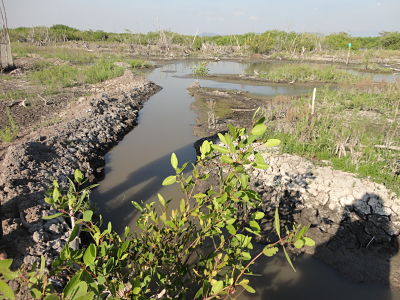

When the goals of mangrove rehabilitation are subordinated to those of climate change mitigation and the creation of carbon sinks, a project can easily fall into the trap of equating effective rehabilitation with simple reforestation. It is important to consider that clear and well-maintained channels allow hydrological flows between salt and freshwater sources in a mangrove. This enables the ecosystem to find a natural balance that favours biodiversity. It also allows the movement of fish to and from the ecosystem in tune with the water flows, and facilitate the natural expansion of the mangroves via greater seed dispersal. Improving hydrological flows may include the removal of mangrove trees in key places, or the absence of them in others. In Marismas Nacionales, the rehabilitation project went through a steep learning curve that included waste of time and resources, resulting from a traditional approach of reforestation, involving raising, planting and caring for seedlings. After 2-3 years, the policy was changed to one of creating and maintaining channels and flows between the lagoons in the reserve, and thus encouraging a natural system's rehabilitation.
a) A committed local community workforce who is convinced of the benefits of rehabilitating the mangroves, and does not do it just for the payment;
b) highly trained fieldworkers, with scientific knowledge, who can guide the effective rehabilitation of mangroves, and quickly modify their approach if needed;
c) a sustainable, intelligently targeted public programme of payments for local communities;
d) understanding the pressures and root causes of the mangrove system’s problems.
a) Without good technical, scientific guidance it is not possible to rehabilitate mangrove ecosystems in a manner that is sustainable, or sustainable for local livelihoods.
b) When goals of mangrove rehabilitation are subordinated to those of climate change mitigation (carbon sink creation), it can be easy to confuse good rehabilitation with simply increasing the number of trees.
c) Creating and maintaining channels within the mangrove system in order to facilitate natural flows between salt and freshwater sources is a key component for reducing salinization problems, as well as for maintaining mangrove's health.
d) Problems for mangrove systems can be exacerbated by climate events such as tropical storms that destroy parts of the mangroves. However, chronic problems can be caused by upstream activities, such as a reduction in river flows due to water over-extraction for agricultural purposes. This increases the salinity problems of the mangrove systems.